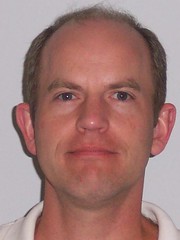Nanosolar: Photovoltaic Hindsight Insights? REVISED
 Reviewing the efficiency calculation.
Reviewing the efficiency calculation. Building on my prior post, Nanosolar: Photovoltaic Hindsight Insights?, “Nanosolar to Build 10MW Power Plant” by Ucilia Wang at Greentech Media obtained feedback on the story from Nanosolar, Inc. Chief Executive Officer Martin Roscheisen:
Roscheisen also wrote that two technical details in the newspaper articles were wrong. The June article said the size of the glass plate for a finished panel measures at 2 square meters. Roscheisen wrote that Nanosolar's panel is "compatible with First Solar's, which are 1.6 x .8m in size."
Roscheisen added that the 7,000 panels reported for the 1-megawatt plant also was wrong, but didn't offer the correct number.
Well, Nanosolar partner Beck Energy GmbH has First Solar’s FS Series 2 Solar Module datasheet (Deutsch) on their website, and the First Solar module dimensions are in fact 1.2 x 0.6m (meters).
Looking at the Nanosolar module array photo shown in Nanosolar solar modules shipping!, the modules are arranged as five (5) by ten (10) CIGS (copper indium gallium diselenide) rectangular looking solar cells. I do not believe Nanosolar has ever stated the cell size; they appear to be about 6” (156mm) square in area terms? This rough sizing would confirm the 1.6 x 0.8m panel size.
Using the 1.6 x 0.8m panel size cited by Mr. Roscheisen and the calculated 142.9 Watts per module assuming the 7000 panels remains reasonable, the implied Nanosolar Utility Panel module efficiency becomes 11.16%.
First, do I need to point out the 142.9 Watts per module would be an average module efficiency for the entire 1 MWp (MegaWatt-peak) installation? Per Sorted-Cell Assembly, Nanosolar’s metal foil substrate cells can be tested, binned, and matched to increase module efficiency and yield much like crystalline silicon based solar cells. No doubt the unpublic Nanosolar Utility Panel module datasheet includes a range of power ratings. However, without Nanosolar cell or module production efficiency data in histogram form, it is impossible to determine if more or less than 7000 modules are required for the 1 MWp Luckenwalde landfill project as Mr. Roscheisen asserts. For example, if the average module efficiency is 12% (153.6 Wp, Watt-peak), about 6500 modules would be required for the 1MWp installation, while 10% average module efficiency (128 Wp) would require just over 7800 modules.
From the Nanosolar Wikipedia entry, I found this award winning article, “Solarzellen - einfach gedruckt” (“Solar cells – simply printed”, German only) by Johannes Bernreuter for bild der wissenschaft 2|2007, also referenced by the Nanosolar website. The article delves into the history of the nanoparticle CIGS printing technology and past efficiency, potential, and verified efficiency results. Please remember the “14.5% Cell Produced Using Low-Cost Printing Process” touted by Nanosolar was for a 0.47 square centimeter cell printed on a glass substrate. NREL (National Renewable Energy Laboratory) measured the cell’s efficiency at 13.95% in August 2006, and Nanosolar said:
NREL measured one of Nanosolar’s cells on glass at about 14% on a total-area basis, equivalent to about 14.5% on an active-area basis after correcting for shadowing by the grid (Voc = 599mV, Jsc = 32.2mA/cm2, FF = 72.3).
To our knowledge, this is the highest efficiency yet reported for any printed solar cell of any kind and any CIGS cells fabricated using non-vacuum methods in particular.
in the PVSEC-17 paper, “HIGH-PERFORMANCE THIN-FILM PHOTOVOLTAICS USING LOW-COST PROCESS TECHNOLOGY”.
I hesitate to share this. One of my favorite German restaurants near Luckenwalde, Landgasthof "Zum Märkischen Eck", is about a 20 minute drive from Nanosolar GmbH. It’s worth a visit; just make sure to save a table for my relatives and me!











